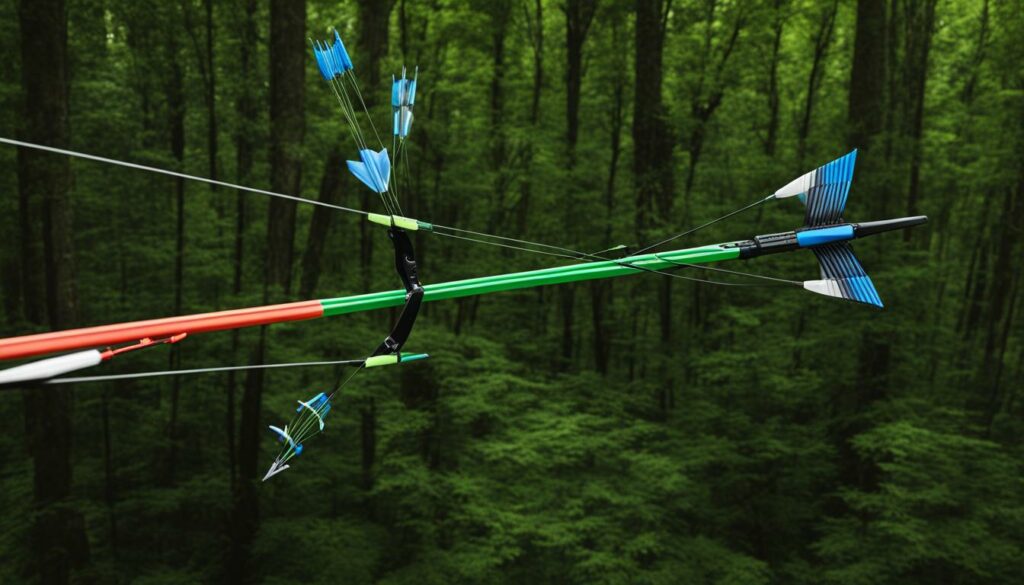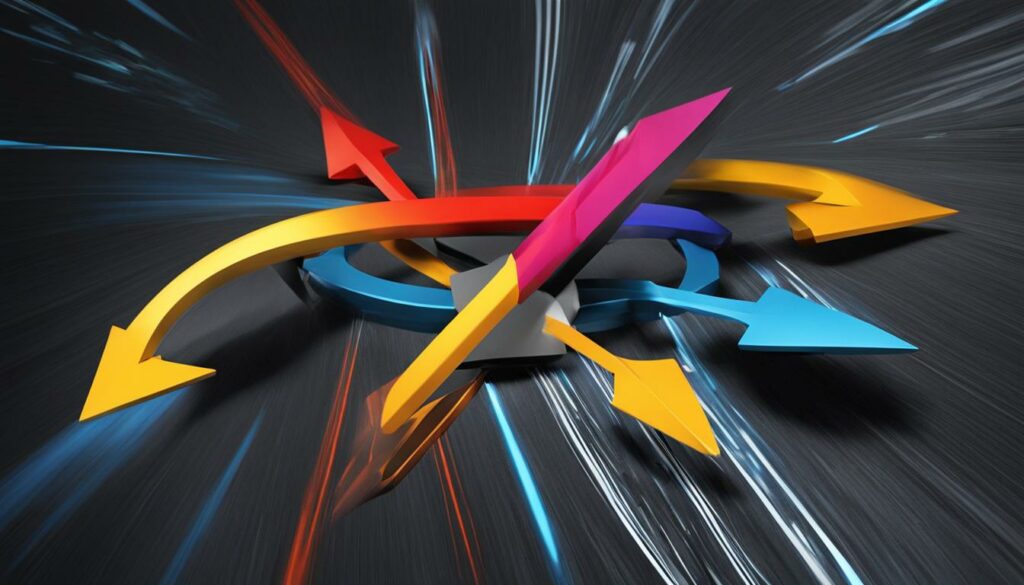One of the most frequently asked questions about compound bows is, “How fast do they shoot?” Understanding the speed capabilities of compound bows is essential for both archery enthusiasts and bowhunters.
The shooting speed of compound bows is measured in feet per second (FPS). Most compound bows on the market have advertised speeds between 300 and 340 FPS. However, it’s important to remember that these speeds are typically measured at point-blank range and may be lower when the arrow reaches the target.
Various factors, including draw length, draw weight, and arrow weight, determine the speed of a compound bow. The International Bowhunting Organization (IBO) uses specific testing standards to measure bow speed. These standards involve a 70 lbs. draw weight, a 30″ draw length, and a 350-grain arrow.
Modifications to these factors can significantly impact arrow speed. For example, reducing the draw length by 1″ can reduce the speed by around 10 FPS, while reducing the draw weight by 10 lbs. can decrease the speed by 15-20 FPS.
Additionally, every 5 additional grains in arrow weight can reduce the speed by 1.5 FPS. Other factors, such as accessories on the string and the release method, can also impact the overall speed of the bow.
Understanding Arrow Speed
Arrow speed is crucial in bowhunting, significantly impacting shot placement and overall effectiveness. A faster arrow offers a larger margin of error and improved accuracy, allowing for more precise shot placement. For example, increasing arrow speed from 260 FPS to 320 FPS can extend the effective range by over 300%.
However, it is crucial to strike a balance between speed and accuracy. Excessive speed can negatively affect accuracy, especially when using fixed-blade broadheads or if the bow is not tuned correctly. Therefore, finding the optimal arrow speed that enables accurate shooting while delivering sufficient kinetic energy for hunting is essential.
Factors Affecting Arrow Speed
Several factors come into play when it comes to the arrow speed of a compound bow. Understanding these factors can help bowhunters optimize their equipment and achieve optimal performance. The key factors that impact arrow speed include:
Draw Length
The draw length of a compound bow refers to the distance the bowstring is pulled back before releasing the arrow. A shorter draw length can significantly impact arrow speed, with every 1″ reduction resulting in a loss of around 10 FPS (Feet per Second).
Draw Weight
The draw weight of a compound bow refers to the force required to pull the bowstring back to a full draw. Reducing the draw weight can also decrease arrow speed. On average, every 10 lbs. reduction in draw weight leads to a 15-20 FPS decrease.
Arrow Weight
The weight of the arrow itself can affect its speed. As the arrow weight increases, the speed decreases. Every additional 5 grains in arrow weight typically reduces speed by around 1.5 FPS.
Accessories on String
Accessories such as a D-loop and peephole attached to the bowstring can impact arrow speed. These accessories create additional friction and reduce speed by 5-6 FPS.
Release Method
The method used to release the bowstring can also impact arrow speed. When releasing the string manually, the speed can be reduced by 2-3 FPS compared to the International Bowhunting Organization (IBO) speed rating.

The Impact of Bow Setup on Speed
The specific configuration of the bow, including factors like draw weight, draw length, and accessories, can significantly impact its actual speed. To illustrate this, let’s examine a real-life example:
Suppose a bow has an advertised speed of 320 FPS (Feet per Second) according to the International Bowhunting Organization (IBO) standards. However, if a beginner shooter chooses to use a 60 lbs. draw weight, a 28″ draw length, accessories on the string, and a 425-grain arrow, the actual speed of the bow would be reduced by approximately 67 FPS. This means that the bow’s actual speed would be around 253 FPS.
If the shooter opts for a 70 lbs. draw weight and a 30″ draw length, the speed would be closer to 270-290 FPS. This demonstrates the significant influence of bow setup on speed.
Archers need to understand that the actual speed achieved may be lower than the advertised speed due to various factors related to the bow setup. Managing expectations and fine-tuning the setup to optimize speed are crucial steps for any archer to maximize their bow’s performance.
For a visual representation of how bow setup impacts speed, refer to the following example:
| Bow Configuration | Draw Weight | Draw Length | Accessories | Arrow Weight | Actual Speed |
|---|---|---|---|---|---|
| Beginner Setup | 60 lbs. | 28″ | Yes | 425 grains | 253 FPS |
| Optimized Setup | 70 lbs. | 30″ | No | 350 grains | 270-290 FPS |
In the example above, the optimized bow setup results in a higher actual speed than the beginner setup, showcasing the tangible impact of bow configuration on arrow velocity.
The Relationship Between Speed and Kinetic Energy
While speed is essential in bowhunting, the relationship between speed and kinetic energy is equally crucial. Kinetic energy refers to the energy possessed by an object in motion, in this case, the arrow. A higher kinetic energy means more stopping power upon impact, regardless of the arrow’s speed.
Even if the arrow is slower, it can still deliver a significant punch with higher kinetic energy. In the example mentioned earlier, with a speed of around 255 FPS, the bow would still have enough kinetic energy (between 42-65 ft-lbs) to take down large game animals in the United States.
However, it’s important to note that accuracy and shot placement are critical factors when hunting. While a slower arrow with higher kinetic energy can still be effective, it is essential to ensure precise shot placement for a clean and ethical harvest.
It’s worth noting that kinetic energy decreases as the arrow travels further due to factors like air resistance. Therefore, hunters should be mindful of the range and choose a combination of speed and kinetic energy that suits their specific hunting needs and conditions.

The Pros and Cons of Higher Arrow Speed
Increased arrow speed offers several benefits in archery and bowhunting. Understanding the advantages and disadvantages is essential to making informed decisions about your equipment and shooting technique. Let’s explore the pros and cons of higher arrow speed.
Benefits of Increased Arrow Speed
- Improved Shot Accuracy: Faster arrow speeds enhance shot accuracy, providing a more precise and consistent trajectory. This can result in tighter groupings and increased confidence in hitting the target.
- Increased Effective Range: Higher arrow speeds extend the effective range of your shots. This means you can confidently take shots from greater distances, expanding your hunting opportunities and enhancing your overall archery experience.
- Better Odds of Hitting Vital Areas: With increased arrow speed, you have better odds of hitting vital areas on the target, such as the lungs or hearts of game animals. This improves your chances of making clean and ethical kills.
Drawbacks of Excessive Speed
- Difficulty Controlling Fixed-Blade Broadheads: Excessive speed can make it more challenging to control fixed-blade broadheads. The high velocity may cause these broadheads to plane or veer off course, leading to accuracy issues and potentially affecting the outcome of your shot.
- Accuracy Issues Due to Poor Form or Improper Tuning: Proper form and ensuring your bow is well-tuned is essential to harness the benefits of higher arrow speed. Poor form or improper tuning can lead to accuracy issues. The increased speed amplifies inconsistencies, making it crucial to practice proper shooting techniques and regularly maintain your equipment.
The key is to find the right balance between speed and accuracy. Achieving the optimal arrow speed for your needs and shooting style is a process of experimentation, practice, and fine-tuning. It’s advisable to consult with experienced archers or bow technicians to guide you in selecting the right equipment and setup.
Choosing the Right Bow and Setup
Numerous factors contribute to the overall effectiveness of a bow, including axle-to-axle length, peep height, D-loop, string servings, and cam type (such as binary, solo, hybrid, or dual). Each element determines the bow’s accuracy, speed, and overall shooting experience.
To ensure you find the perfect fit, it is highly recommended that you visit archery shops and seek professional guidance. Experienced professionals can provide valuable insights and help you find a bow that suits your needs and shooting style.
They will assist you in trying out different models, considering factors like brace height and evaluating personal shooting form, which are crucial in making the right choice.
Additionally, regular practice and proper maintenance are key to maximizing the performance of your chosen bow. By dedicating time to practice, you can refine your skills and become more familiar with your bow’s characteristics.
Moreover, maintaining your bow properly, including checking for any wear and tear, ensuring proper string alignment, and lubricating mechanisms, will help prolong its lifespan and keep it in top shape for years to come.
FAQ
How fast do compound bows shoot?
Compound bows typically have advertised speeds between 300 and 340 FPS (Feet per Second). However, these speeds are for the point-blank range and will be lower once the arrow reaches the target.
What factors affect the speed of a compound bow?
The speed of a compound bow is determined by factors such as draw length, draw weight and arrow weight. Accessories on the string and the release method can also impact speed.
How does draw length impact arrow speed?
Every 1″ reduction in draw length results in a loss of around 10 FPS in arrow speed.
How does draw weight impact arrow speed?
Every 10 lbs. reduction in draw weight can lead to a decrease of 15-20 FPS in arrow speed.
How does arrow weight impact arrow speed?
Every 5 additional grains in arrow weight can reduce arrow speed by approximately 1.5 FPS.
How do accessories on the string affect arrow speed?
Accessories such as a D-loop and peephole on the string can reduce arrow speed by around 5-6 FPS.
How does the release method impact arrow speed?
The release method, mainly manually, can further reduce the speed rating by 2-3 FPS compared to the International Bowhunting Organization (IBO).
Can you provide a real-life example of the impact of bow setup on speed?
Suppose a bow has an IBO speed of 320 FPS. If a beginner shooter chooses a different draw weight, draw length, and arrow weight, the actual speed of the bow may be significantly lower than the advertised speed.
What is the relationship between arrow speed and kinetic energy?
Arrow speed affects the kinetic energy (KE) of the arrow, which refers to an object’s energy in motion. Higher kinetic energy means more stopping power upon impact.
What are the benefits of higher arrow speed?
Increased arrow speed can improve shot accuracy, increase the effective range, and improve the odds of hitting vital areas on the target.
Are there any drawbacks to excessive arrow speed?
Excessive speed can make it more challenging to control fixed-blade broadheads and may lead to accuracy issues if the bow is not tuned correctly or the shooting form is poor.
How important is it to choose the right bow and setup?
Selecting the right bow and setup is crucial for optimal performance. Factors such as axle-to-axle length, peep height, D-loop, string servings, and cam type contribute to the bow’s overall performance.
